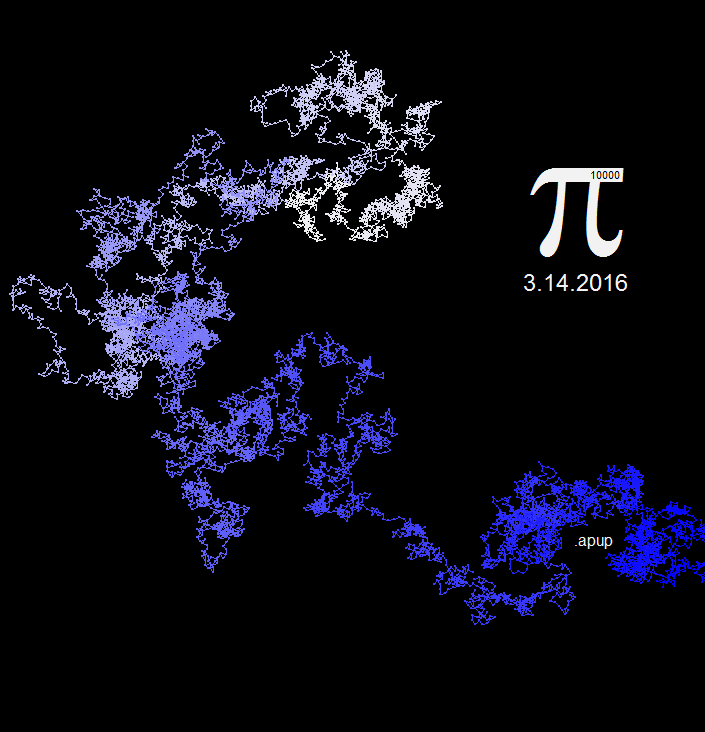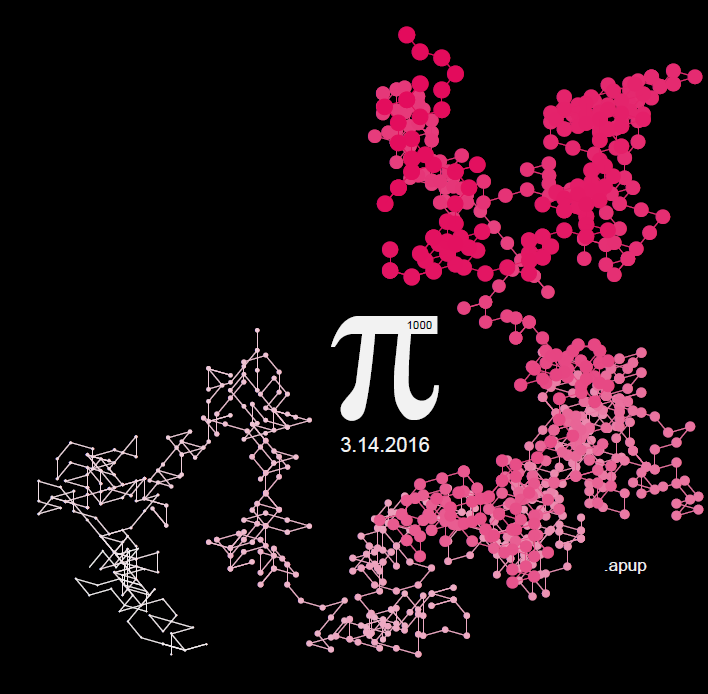3.14.2016 ― Posters for the great Day of π
If Pi would have a profile picture, it could be one of these.

Background
They say that irrational is an act without rationality. A thing without normal mental clarity. It's just something illogical. Therefore, it is my pleasure to celebrate today something logically absurd - the infinite constant Pi. Since today is the Day of Pi (3/14). In details, it's the 28th annual Pi Day and of course I took an unpaid day-off from work for such a Holy Day.
Well, Pi is the most irrational number of them all. It is the ratio of the circumference to the diameter of any circle. Even the ratio is always the same, one is unable to express the number with fraction form - this is why it's called irrational number. Luckily, our calculators are usually nice enough to present the value with the Greek letter π. Because otherwise one would be in trouble as it has infinite amount of decimals. Inserting those to any calculation would be the last thing they put you to do at work...
But how to celebrate this day? On any religious Holy Day or festival, there are traditions to follow. Same goes to Pi. As the Day started from the the Exploratorium [1], one should maybe consider starting from their traditions. These include celebrating the Day at 1:59, doing Pi-related activities and preparing pies! The pie baking will be a piece of cake(!) to execute, but the Pi-centred actions are trickier to create. Since I have hugely admired the Pi-posters from Martin Krzywinski [2], I was inspired to create my very first Pi poster for today.
There do exists scientists and scholars who do research on Pi, its whereabouts and those never-ever-ending digits. And this is all great of course (ppl do need different purposes in life...) - but does the search of Pi's digits actually lead anywhere? Well, for my poster project I decided to find it out. The idea would be routing the digit appearances. Awesome.
Execution
 The idea is to draw continuous line formation from Pi decimals, where each step has a length of 1 unit and the direction of the digit. Surprised or not, there are actually 10 digits in our Arabic numerals. Since they are all also found in the Pi decimals, I created simply a direction for each digit appearance.
A direction has π/5 fraction (=36°) and they develop in clockwise. F. ex. digit '1' would be inserted 1 unit in direction of π/5 from the north to east.
The idea is to draw continuous line formation from Pi decimals, where each step has a length of 1 unit and the direction of the digit. Surprised or not, there are actually 10 digits in our Arabic numerals. Since they are all also found in the Pi decimals, I created simply a direction for each digit appearance.
A direction has π/5 fraction (=36°) and they develop in clockwise. F. ex. digit '1' would be inserted 1 unit in direction of π/5 from the north to east.
For execution tool I used R and started to make prototypes. For the final visual presentation, I tried several modifications. Trial and errors showed that the direction flow was basically impossible to distinct without any other graphical feature. Junk of dots isn't actually that informative. Due that notice I added also a colour component to symbolize the development. The mild grey shade is the beginning of the route, where as bright colours are the end points. Also adding dots on step junctions made the route more concrete.
I'll start the route map experience by loading the digits. First 100'000 should be enough - at least for the beginning. First result with 1000 digits became a pretty one, poster presented below. I named it Raspberry Pi [3]. Pun intended. As the amount of dots were small enough, enlarging the dot size by index created nice adjustment. To me, it do look like a berry bush with roots and berries.

The raspberry actually points out already some phenomenon with these posters - there tends to be a flow path. I was assuming that I would get a random mess of dots, that would be centred around same coordinates. But even with jamming in same levels for a while, the direction tend to get some sense of orientation and moves on.
To test whether the flow path is just a product of my data sample, I took bigger sample of 10'000 digits and draw an output of that one. This one I had to name naturally Blueberry Pi (yes, due lack of imagination). The poster is shown in the beginning of this page. With blueberry, the flow seems definitely to be a feature - not a bug! It is quite amazing how in times there are very thin and clear path strings. The direction is also result from digit appearance frequencies and opposite direction ratios. Even digits are quite evenly appearing here (sample of 10'000), some digits do occur less frequent than others. Such as 0, 3, 7 and 8 appear less than 1 or 5.
End result
Now after all that stepping and dotting, where are you going Pi? It seems to me, that you are in counter-clockwise twirl. Your steps are either guided by direction, moving as a thin pearl necklace. Or jammed in group panic, forming a point slash till you find your balance and are on your route again. Even the twirl direction is a result from my initial direction settings, it's still rewarding to observe that the overall formation is still making a semi-readable pattern. Maybe the digits are not so random after all.
Even Pi is unable to be presented in the form of fraction number, fraction 22/7 gives a fair estimate to it. Hence, I should make a rendezvous to this topic on the alternative Pi Day - 22nd of July. Better put it on the calender.
All work and no pie makes Pup a lull gal.
I should bake a pie now, since the cake is a lie [4] anyway... ∎